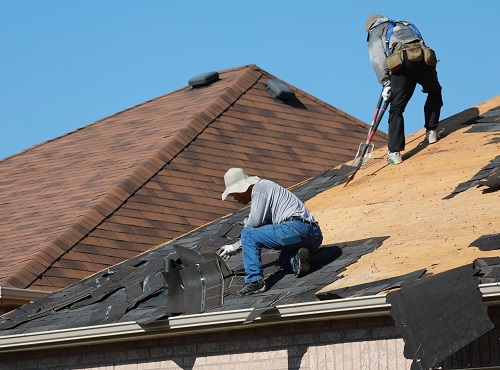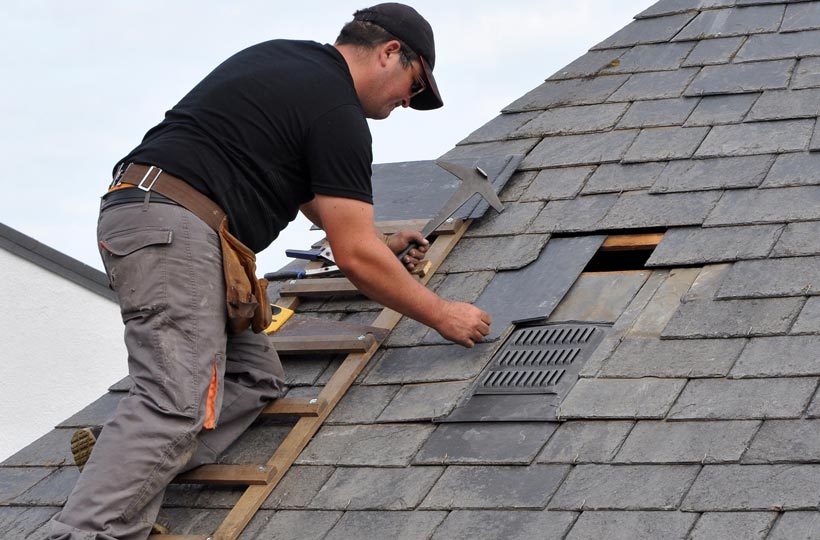Roof Repair Coverage Details Every Homeowner Needs
Wiki Article
Indicators You Required Roof Fixing: Protect Your Financial Investment With These Easy Checks
Recognizing the indications that suggest a need for roof repair work is vital for safeguarding your building and investment. Common indications such as missing out on tiles, unforeseen water stains, and granules accumulating in gutters can suggest underlying issues that, if left unaddressed, may escalate right into even more severe issues. Additionally, indicators like drooping locations or increased power costs can also direct to ineffectiveness or damages. To assure your roof covering remains in top condition and to stay clear of costly repair work, it is necessary to recognize these early caution indicators and act accordingly. What steps should you take following?Missing or Harmed Roof Shingles
When reviewing the condition of your roof covering, among one of the most telling signs of possible problems is the existence of missing or harmed roof shingles. Tiles offer as the first line of defense against the components, and their stability is important for keeping the overall wellness of your roof system - I&E Roofing & Construction, Inc.. A few missing out on shingles might seem small, yet they can lead to significant water seepage, compromising the underlying structure and necessitating a lot more extensive fixingsDamaged tiles can materialize in various ways, consisting of curling, splitting, or blistering. Each of these conditions can minimize the efficiency of your roof, enabling dampness to permeate and lead to a lot more severe troubles. Roofing Service. It is vital to conduct regular examinations, particularly after serious weather events, as high winds and hefty rainfall can exacerbate roof shingles damage
If you identify missing out on or harmed tiles, it is a good idea to address these problems quickly. While minor repair services might be manageable for a home owner, substantial damages often calls for specialist treatment. Prompt activity can avoid additional issues and guard your financial investment, making certain the durability and efficiency of your roof.
Water Spots on Ceilings
Water stains on ceilings are typically clear indications of underlying water damages that calls for instant focus. Identifying the resource of these discolorations is essential, as they can arise from different problems, including roofing system leakages or pipes issues. Dealing with the origin not just protects against more damages however likewise secures the stability of the home.Recognizing Water Damage

When evaluating for water spots, focus on both the size and shape of the discoloration. Uneven forms might suggest ongoing leaks, while more specified locations could indicate past concerns. In addition, take into consideration the area of the stains; stains near plumbing fixtures or exterior walls may supply ideas about potential resources of the water intrusion.
It is likewise vital to examine the texture of the ceiling surrounding the stains. Peeling paint or gurgling drywall can signify substantial moisture exposure, warranting immediate focus. Normal assessments and timely action can help protect against a lot more extreme water damages, shielding both the architectural honesty of the home and the financial investment it stands for. Always seek advice from an expert for a comprehensive evaluation if you discover water discolorations on your ceilings.
Sources of Spots
What factors add to the look of spots on ceilings? Water stains, frequently materializing as stained spots, are largely created by leakages in the roofing or plumbing systems - Roof Repair Company. When dampness permeates via roof materials or jeopardized pipes, it can gather and bring about noticeable discoloration on ceilingsOne usual cause is harmed or missing shingles, which can permit rain to permeate right into the attic room and, at some point, to the ceilings below. Additionally, improper blinking around chimneys, vents, or skylights can be a considerable source of water breach. Plumbing leakages, whether from defective pipes or overruning components, can also develop discolorations, especially in locations directly listed below washrooms or cooking areas.

Recognizing the resource of the tarnish is important for reliable repair work. Overlooking these indications can bring about much more extensive damage, including mold growth and architectural weakening, emphasizing the importance of prompt intervention to safeguard your financial investment.
Granules in Seamless gutters
During routine inspections of your rain gutters, the presence of granules can be a significant sign of roof degeneration. These little, sand-like particles are normally found on the surface area of asphalt tiles, working as a protective layer against UV rays and weathering. In time, deterioration can create these granules to remove, resulting in a range of concerns that might endanger the integrity of your roof.If you discover a buildup of granules in your rain gutters, it is necessary to take this indicator seriously. The loss of granules may reveal the underlying asphalt to the aspects, raising the risk of leaks and water damages. This scenario not only threatens your roof's life-span but can additionally lead to expensive fixings if not attended to promptly.
To alleviate possible damage, it is a good idea to inspect your roof covering on a regular basis, specifically after severe weather events. Furthermore, involving a professional professional roofer to assess the problem of your roof shingles can supply valuable insights. Early treatment is crucial to maintaining your financial investment and making certain the durability of your roof. Bear in mind, granules in gutters are not an unimportant concern; they signal the demand for immediate attention and potential repair.

Drooping Roofing Areas
Sagging roofing system areas can indicate serious structural problems that need immediate focus (Roof Repair). Noticeable deformities on the roofing system's surface, integrated with the presence of water stains inside the home, are vital warning signs that ought to not be neglected. Dealing with these issues quickly can stop further damage and costly repairsVisible Roof Covering Deformities
Exactly how can homeowners determine potential issues with their roof coverings? One of one of the most telling signs shows up roof covering defects, particularly drooping locations. A sagging roofing system might appear as dips or contours, showing underlying structural issues that can endanger the honesty of the entire roof covering system. Homeowners should perform regular inspections, looking for any kind of recognizable abnormalities in the roofline.
A number of variables can contribute to noticeable defects, including water damage, inappropriate installation, or the weight of collected snow and particles. If a roof shows up to droop, it may be an indicator of weakened rafters or trusses, which can cause more serious concerns if left unaddressed. A sagging roofing not only endangers the architectural security of the home yet can likewise lead to pricey fixing bills if the problem rises.
If sagging or other noticeable defects are observed, it is advisable to get in touch with a professional roofer. They can examine the circumstance, determine the cause of the sagging, and recommend appropriate repair service remedies. Prompt intervention is necessary to protect your investment and guarantee the longevity of your roofing system.

Water Discolorations Inside Home
The visibility of water spots inside the home typically signifies prospective issues with the roofing system, specifically in areas where sagging has actually been observed. These spots usually show that water is permeating via the roofing product, which can bring about significant architectural damage if left unaddressed. Drooping roof covering locations may be brought on by a selection of variables, consisting of inadequate assistance, built up moisture, or the wear and tear of roofing products.When you notice water discolorations, it is crucial to check out the source of the dampness. Search for indications of sagging in the roofing framework, as this can exacerbate the issue. Frequently, sagging areas can catch water, leading to leaks and additional damages. Furthermore, it is necessary to assess the age of the roof covering; older roofing systems are extra vulnerable to use and tear, increasing the chance of leaks.
Motivate action is needed to reduce damage. Speak with a qualified roof professional to evaluate the circumstance and suggest suitable fixings. Ignoring water discolorations and check my reference drooping can cause expensive repairs and compromise the integrity of your home. Protect your investment by attending to these indications before they rise into much more serious issues.
Raised Energy Bills
An unforeseen spike in power expenses can frequently signal underlying concerns with your roof. When your roof covering is jeopardized, it can bring about substantial air leaks, permitting conditioned air to run away and unconditioned air to penetrate your home. This inefficiency forces your heating and cooling down systems to work harder, resulting in raised power intake and greater energy expenses.One usual culprit is damaged or missing out on shingles, which can reveal your home's inside to the aspects. Additionally, poor insulation because of roofing system damage can add to energy loss. If you see a constant increase in your energy costs without a matching adjustment in use routines, it is crucial to examine potential roof-related problems.
Normal roof inspections are necessary for identifying problems before they rise into costly repair services. Try to find visible indications of wear, such as drooping areas, fractures, or voids. These may indicate that your roof covering is no more supplying the required obstacle against the elements. Attending to these concerns quickly can aid recover your home's energy efficiency and secure your financial investment in the long run. If you presume a problem, speak with a roof specialist for an extensive analysis.
Mold or Mildew Growth
Mold or mildew development on your ceiling or walls can be a clear sign of roof-related concerns, specifically when dampness infiltrates your home. These fungis grow in damp environments and can position major health threats, consisting of respiratory problems and allergic responses. Their visibility commonly recommends that your roofing system may be endangered, enabling water to leak in with leakages or gaps.To assess the circumstance, try to find dark areas or discoloration on surface areas, typically in locations near the roofline or where water could gather (Roofing Companies St Louis MO). Furthermore, look for any water stains, peeling off paint, or soft spots in your ceiling or walls, which may suggest continuous wetness problems
If you discover mold or mildew, it is important to act swiftly. Not only can proceeded wetness damages your home's structural stability, yet it can likewise lead to pricey fixings down the line. Involving a specialist roof covering service provider can aid recognize the resource of the trouble, whether it's harmed tiles, improper ventilation, or various other concerns. Routine examinations and maintenance can aid prevent mold and mildew development and secure your investment, making sure a secure and healthy living environment.
Age of the Roof
Assessing the age of your roofing is essential in determining its total problem and possible demand for fixings. The majority of roof materials have a specific lifespan, generally ranging from 15 to 30 years, relying on the kind of product made use of. Asphalt roof shingles, for circumstances, normally last about 20 years, while steel roofings can withstand for 40 years or more. As roofings age, they become more susceptible to damage from weather, bugs, and other ecological factors.Routine evaluations are important for roof coverings older than 15 years. Signs of wear, such as fractured or curling shingles, missing out on floor tiles, or rust on steel surfaces, indicate that your roof might require instant interest. Additionally, inner signs like water spots on ceilings or wall surfaces can indicate underlying issues linked to an aging roof.
If your roofing system is approaching its anticipated lifespan, take into consideration consulting a professional contractor for an extensive analysis. They can provide understandings on repair work choices or suggest a substitute if needed. Aggressive administration of an aging roofing can stop costly damages to your home and assurance that your financial investment remains protected.
Often Asked Questions
How Usually Should I Inspect My Roofing System for Damage?
Routine roofing examinations are crucial for maintaining the integrity of your home. It is a good idea to evaluate your roofing system at least twice a year, ideally in the spring and autumn, to identify any prospective problems early. Furthermore, after serious weather condition events, such as heavy storms or hail, an extensive examination is suggested. Attending to minor damages without delay can stop expensive repair work and expand the life-span of your roof significantly.Can I Fix My Roofing system Myself?
While it is possible to fix your roofing system yourself, it is important to examine your abilities and the intricacy of the damages. Small concerns, such as changing a few shingles, may be workable for a DIY enthusiast. Considerable fixings or architectural problems often need professional knowledge to assure safety and compliance with structure codes. Always prioritize your security and take into consideration consulting a roof expert for comprehensive damages or if you are unpredictable regarding the repairs.What Are the Typical Sources Of Roofing System Leaks?
Usual root causes of roof covering leaks include harmed tiles, which can happen as a result of age or extreme climate, and poorly sealed vents or blinking that might allow water infiltration. Additionally, blocked seamless gutters can bring about water backup, resulting in leaks. Structural problems, such as sagging roofing systems or jeopardized underlayment, additionally add to this issue. Normal inspections and maintenance are vital to identify these susceptabilities and stop costly damages to your home.Just How Can I Pick a Reliable Roofer?
Selecting a trusted roof covering service provider entails thorough research and assessment. Start by seeking recommendations from trusted resources and checking on-line testimonials. Confirm the service provider's licensing, insurance coverage, and experience in roof covering jobs similar to your own. Demand thorough price quotes and contrast them for openness. Furthermore, ask about warranties and post-installation assistance. A credible specialist ought to communicate plainly and demonstrate professionalism and trust throughout the process, guaranteeing your investment is well protected.What Is the Average Lifespan of Various Roofing Products?
The typical life-span of roof materials varies significantly. Asphalt shingles usually last 15 to 30 years, while steel roofings can endure 40 to 70 years. Timber trembles usually have a life-span of 20 to 40 years, whereas clay or concrete floor tiles can surpass half a century with proper upkeep. Finally, artificial roof covering materials might offer durability similar to traditional choices, commonly lasting 30 to half a century. Understanding these life-spans help in preparing for maintenance and replacement.Report this wiki page